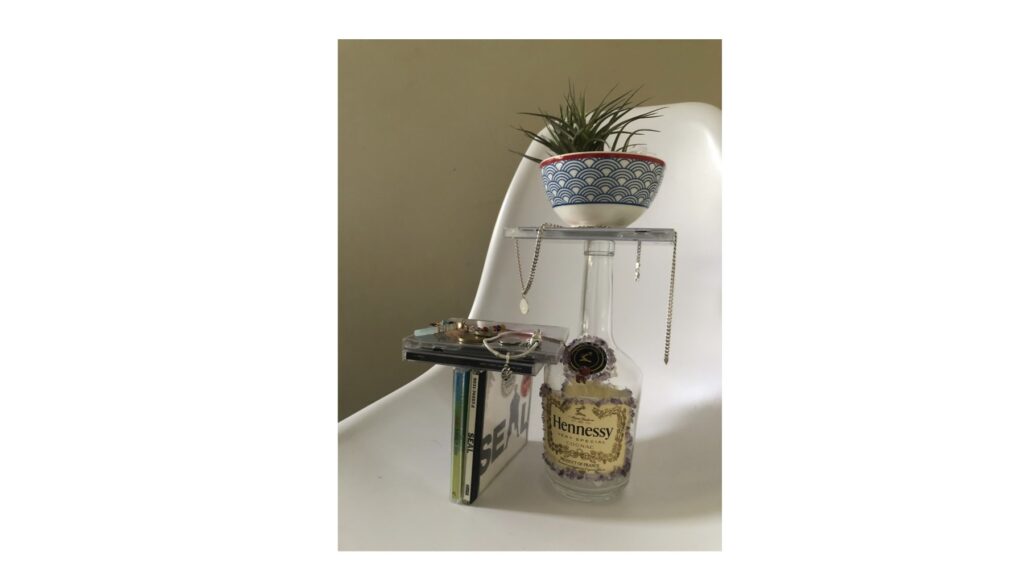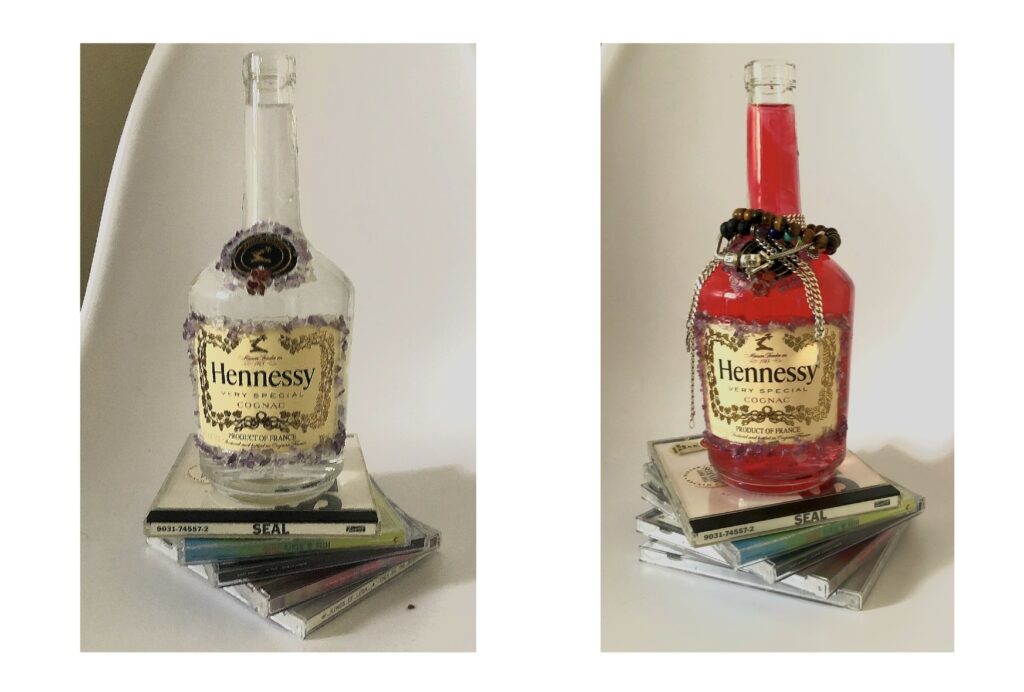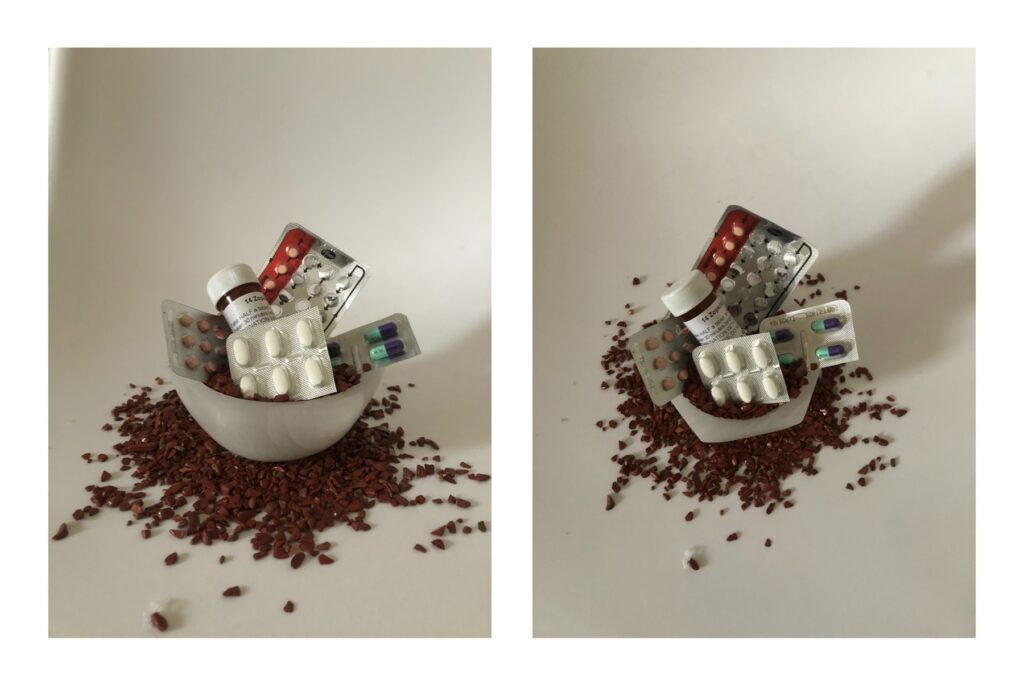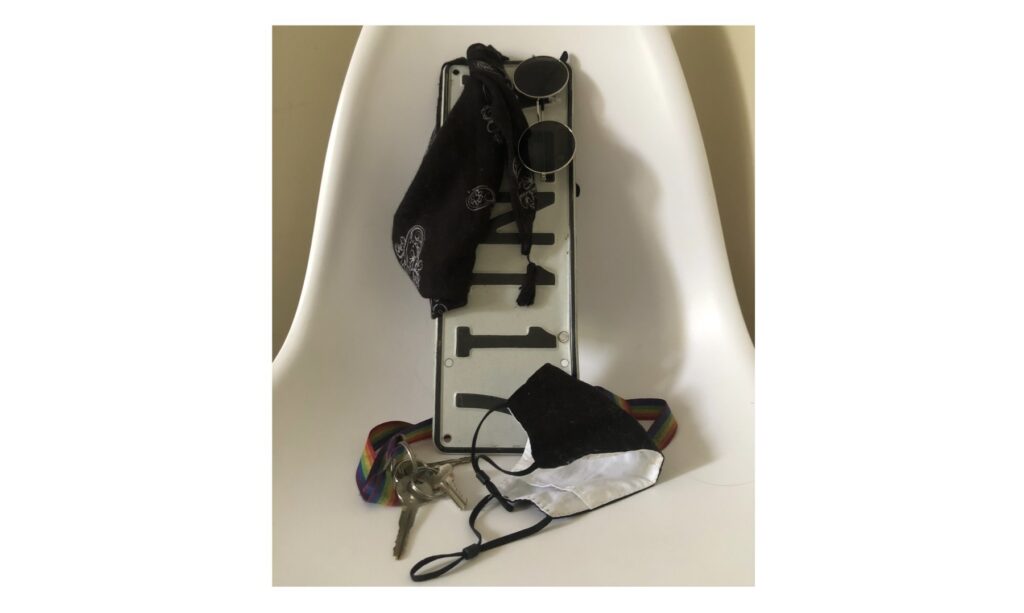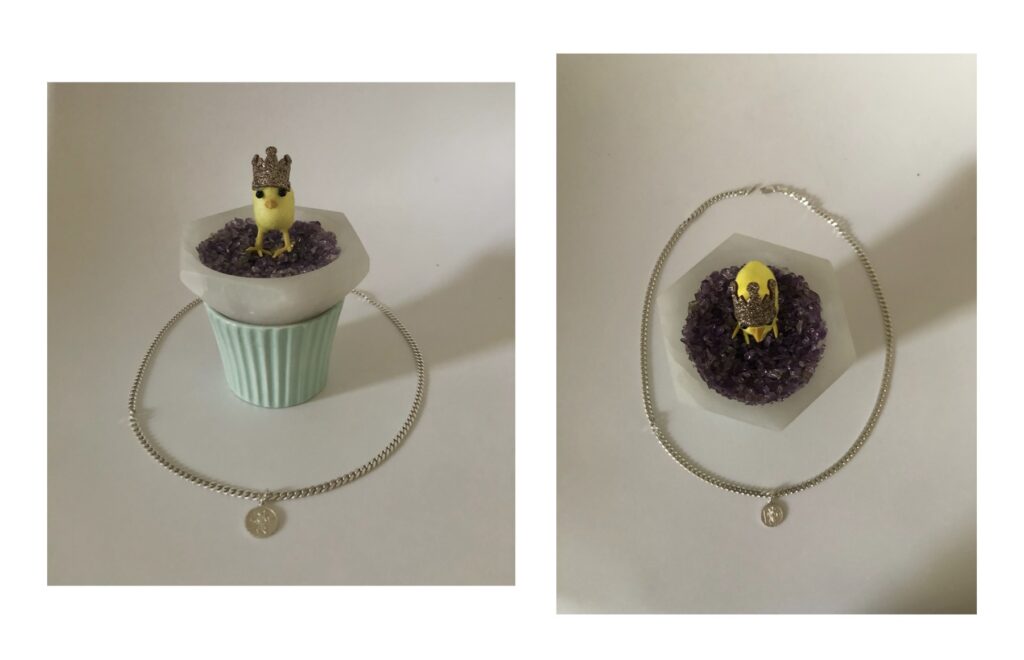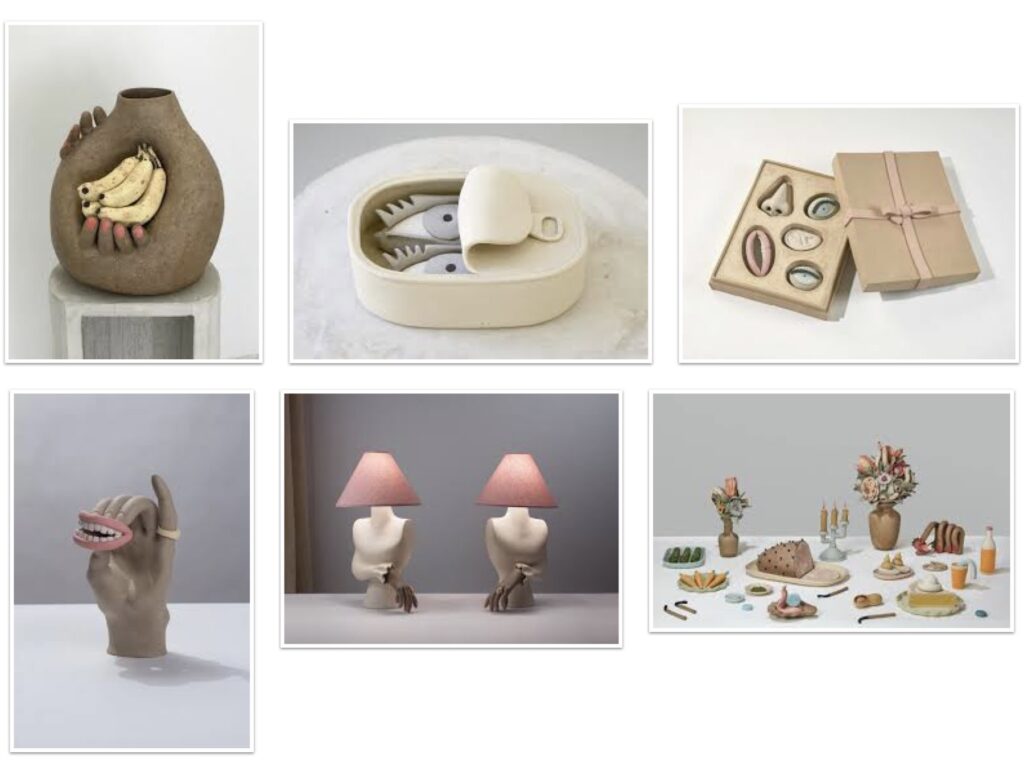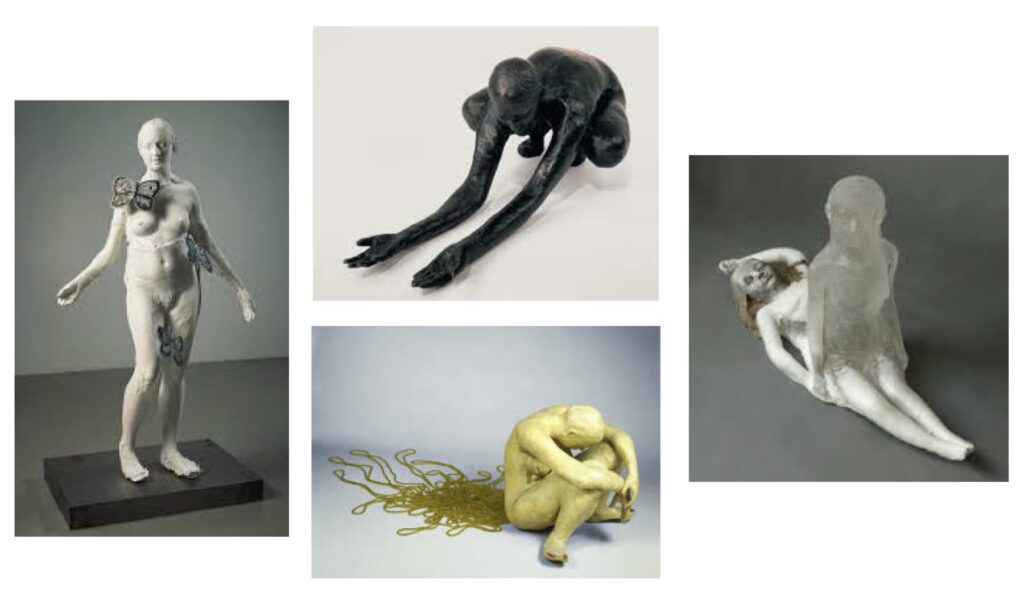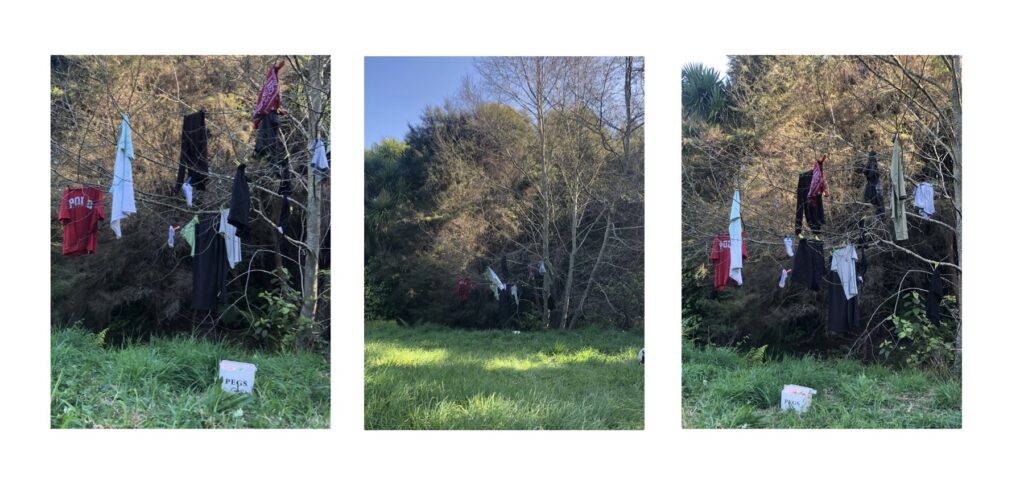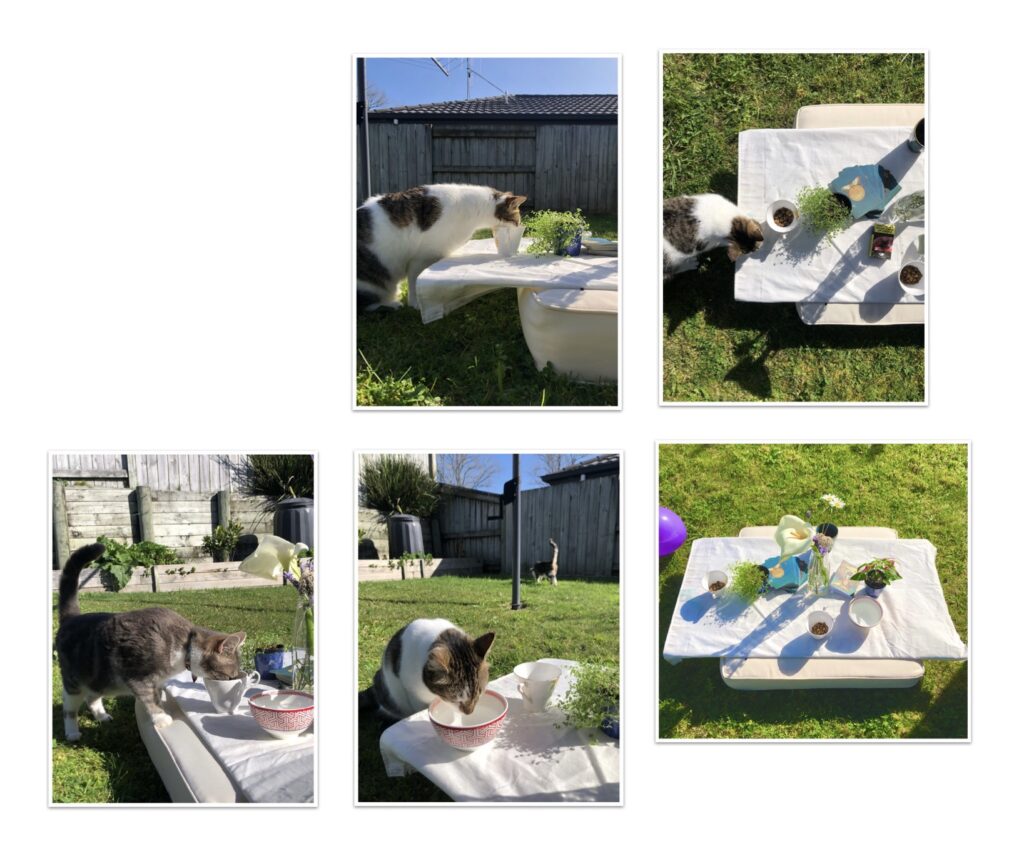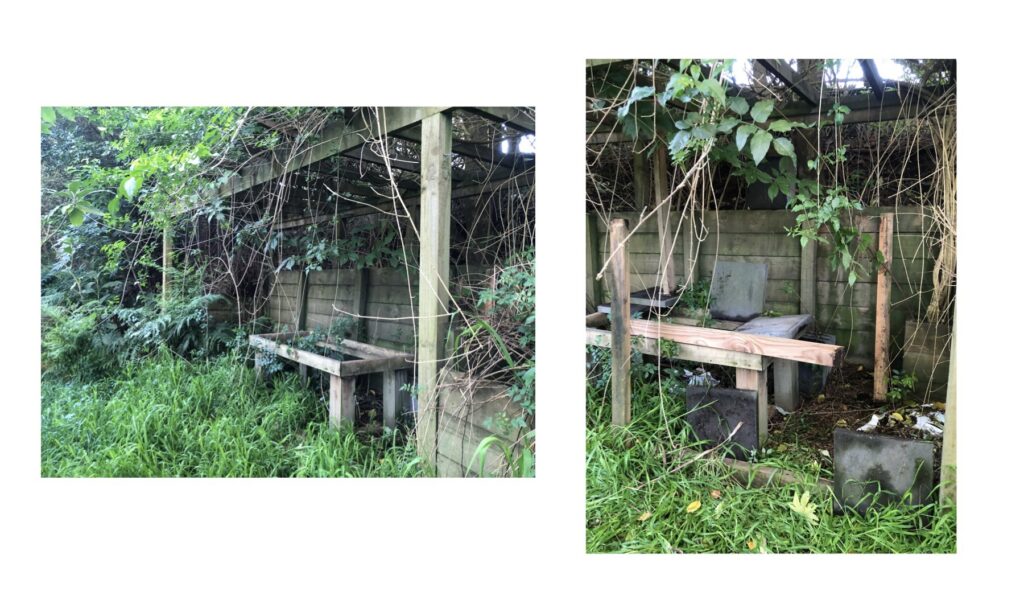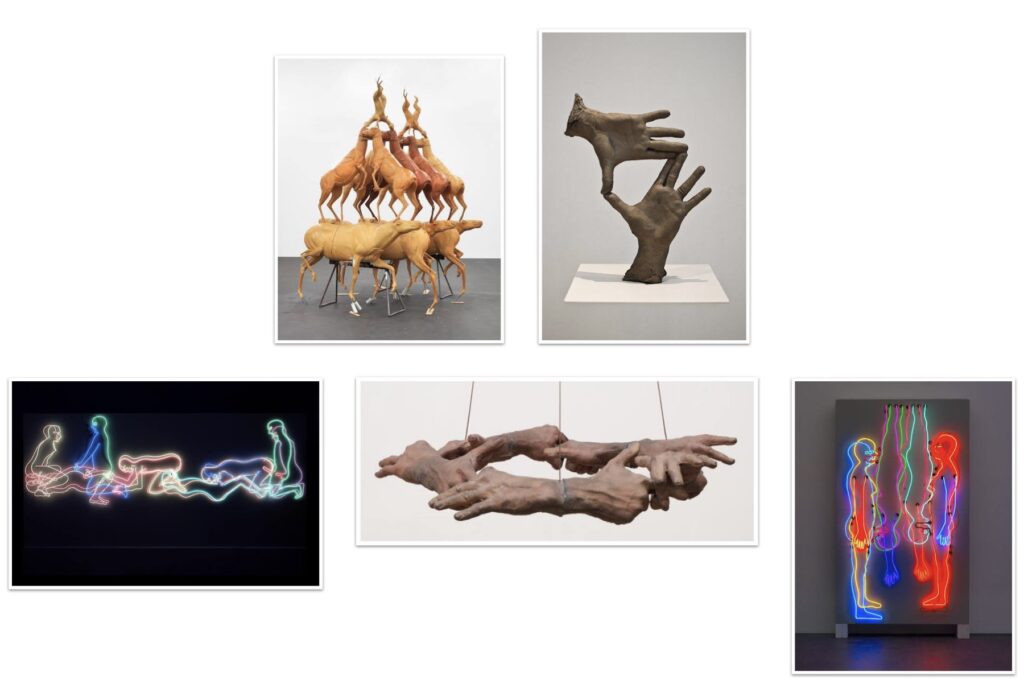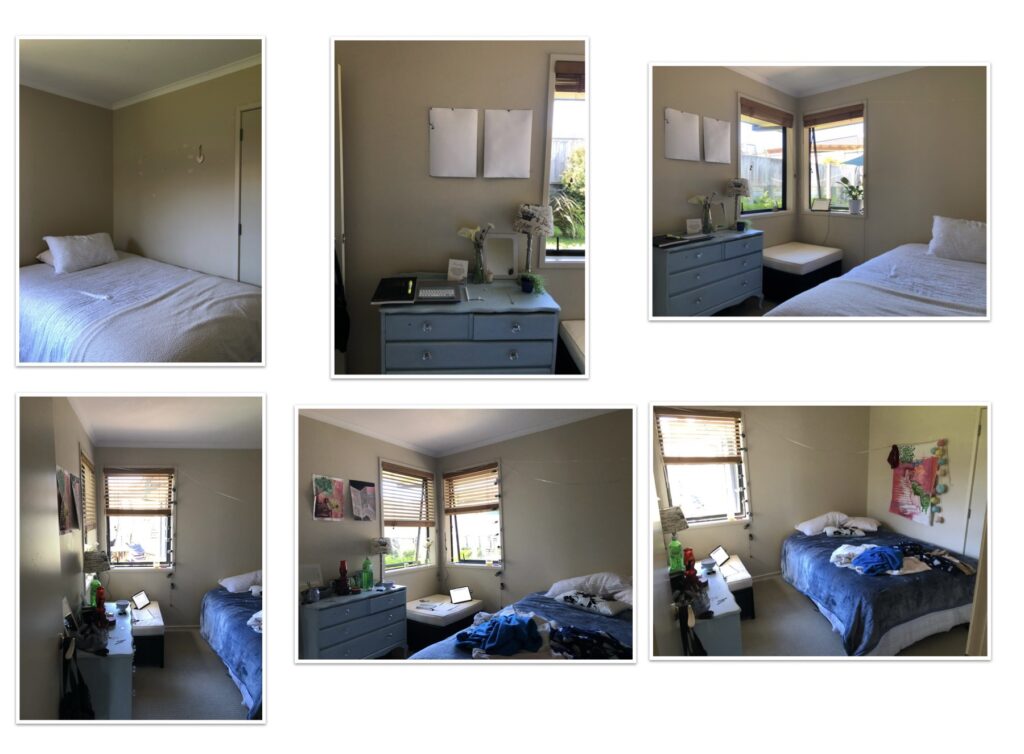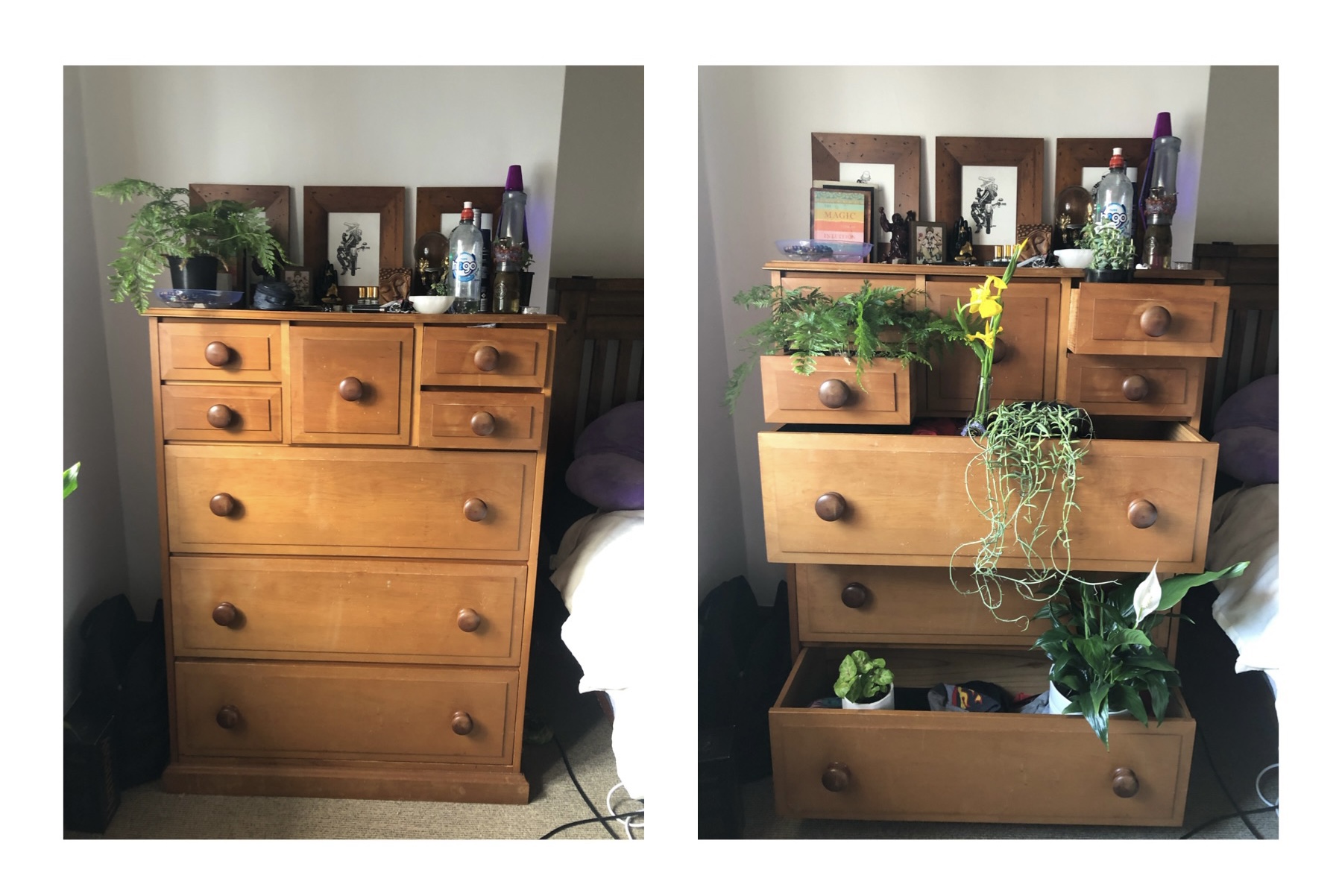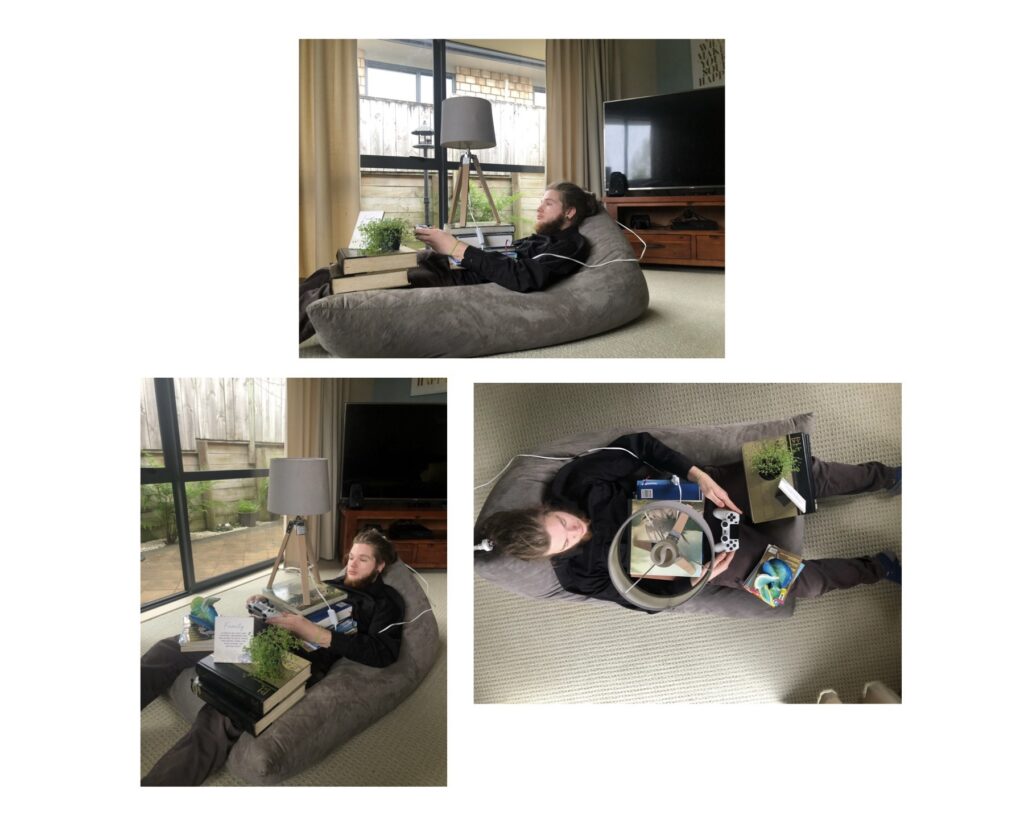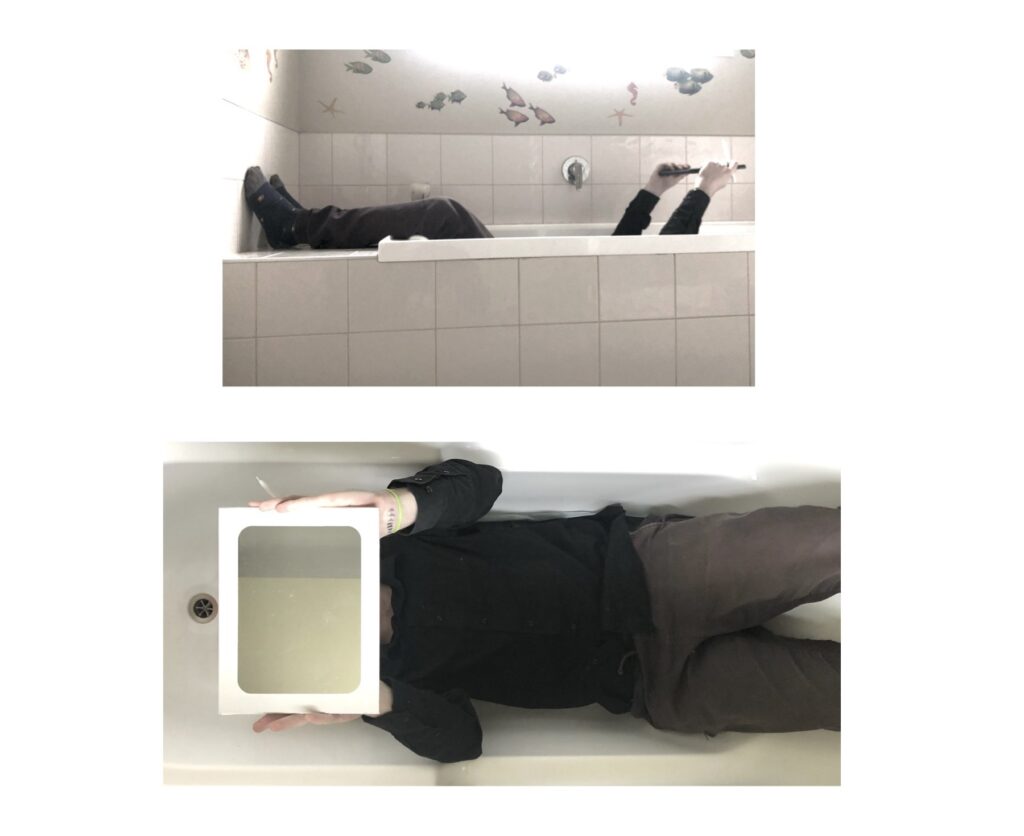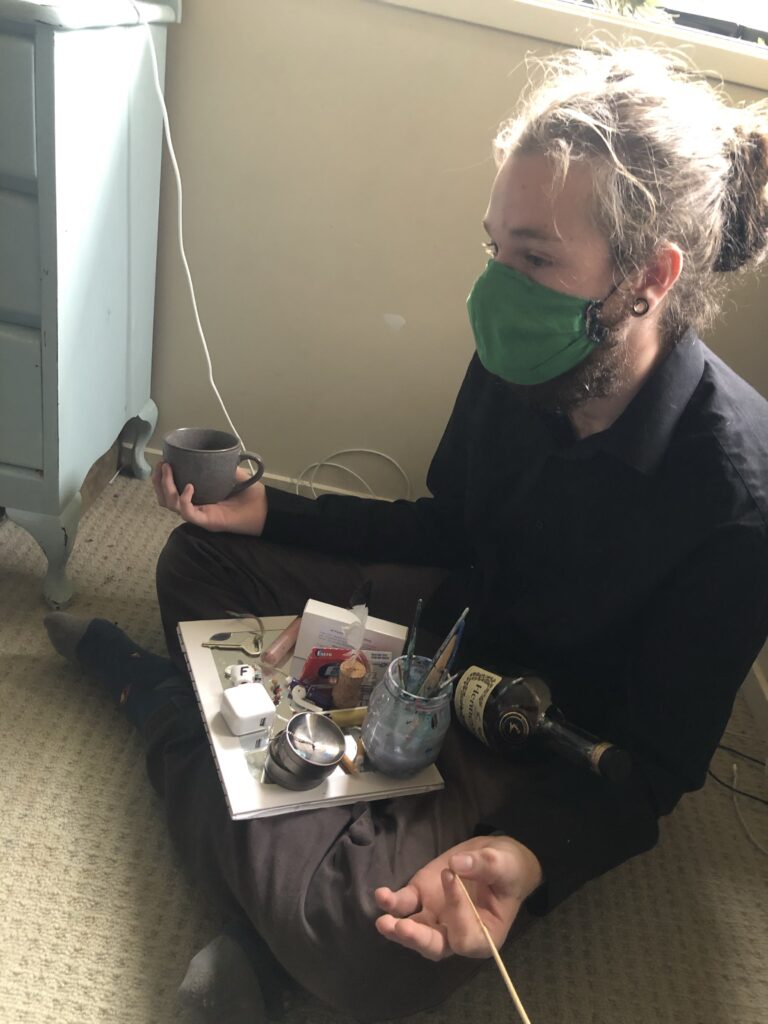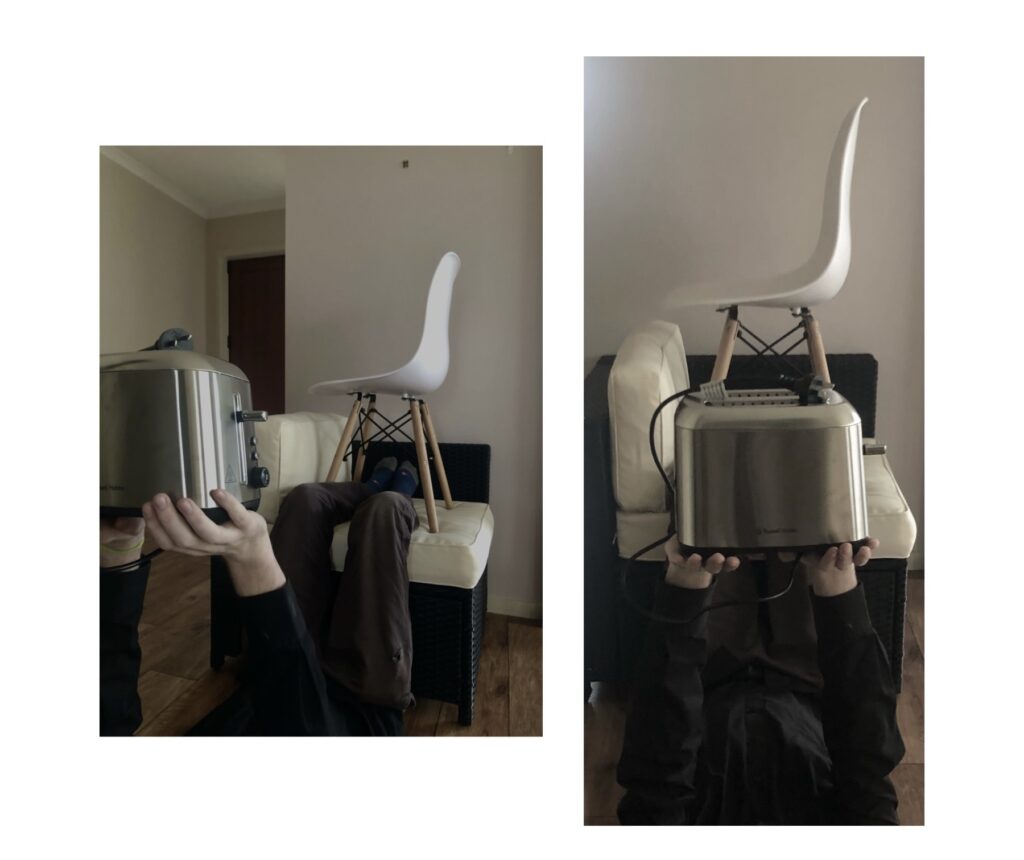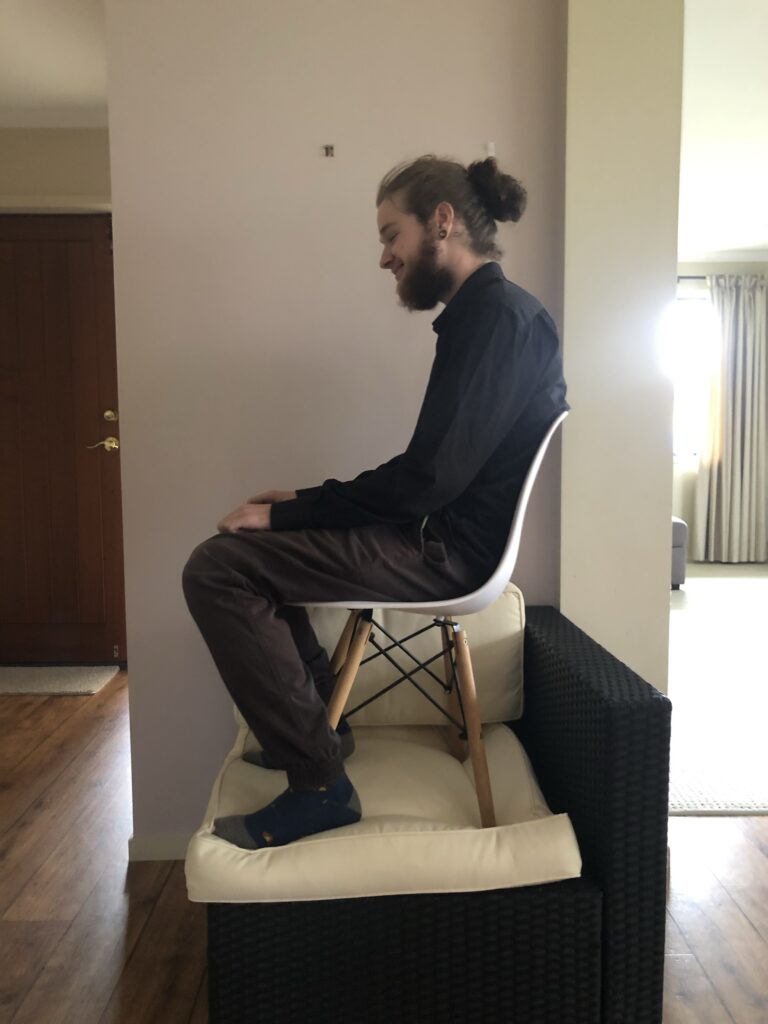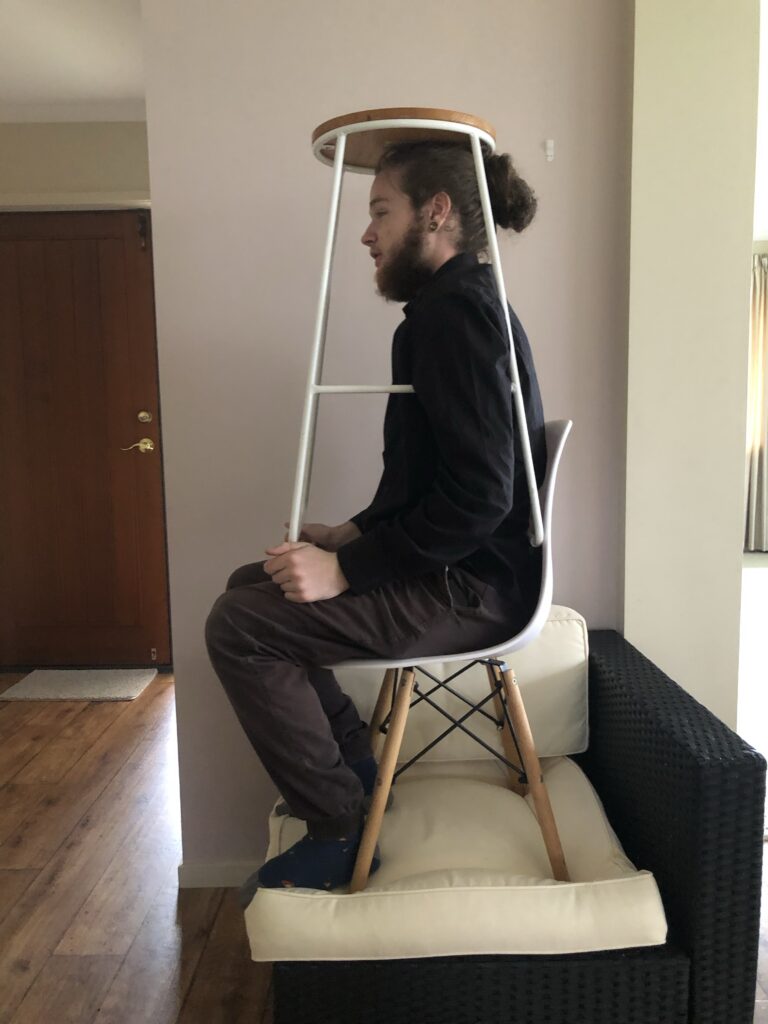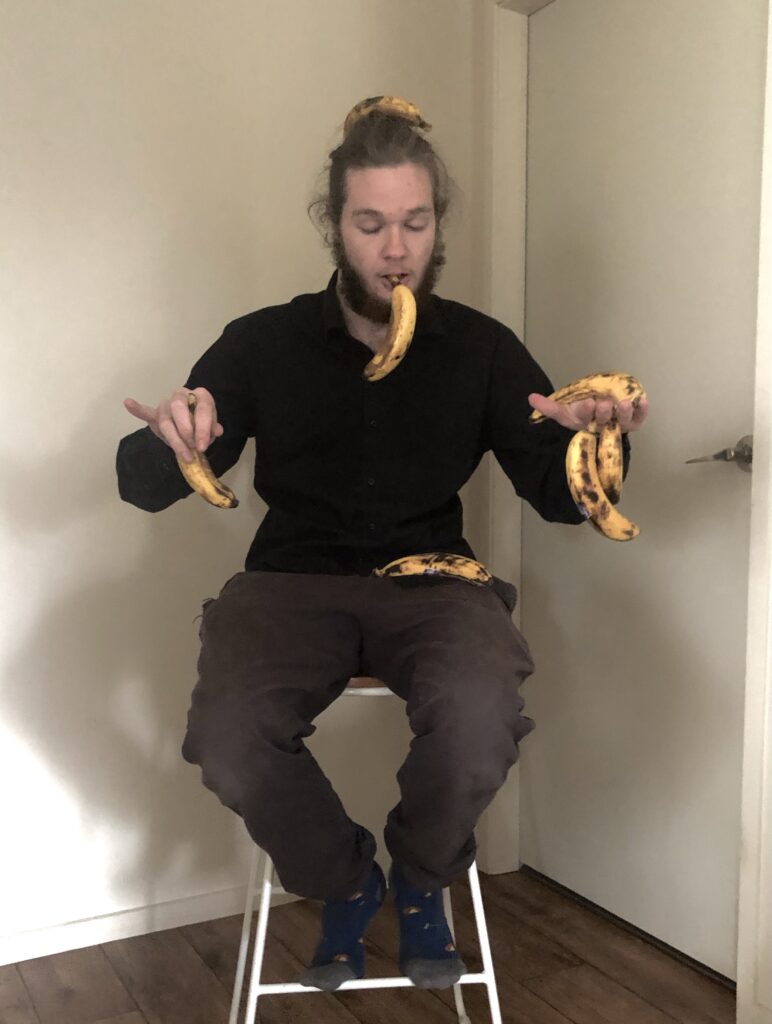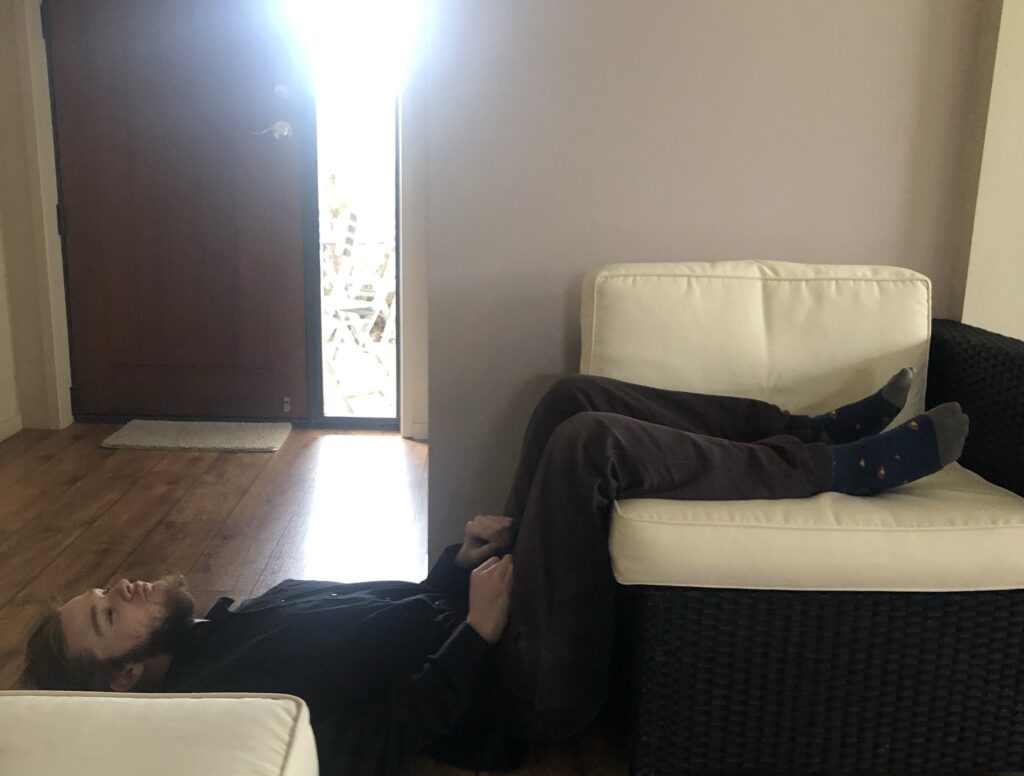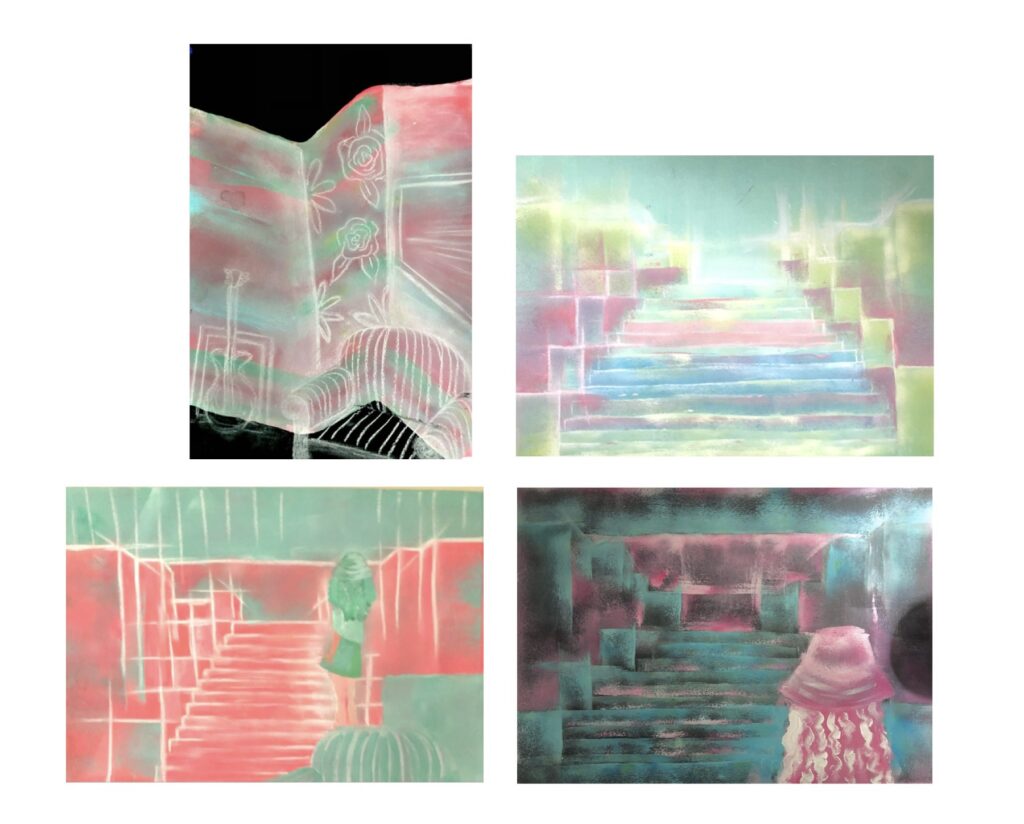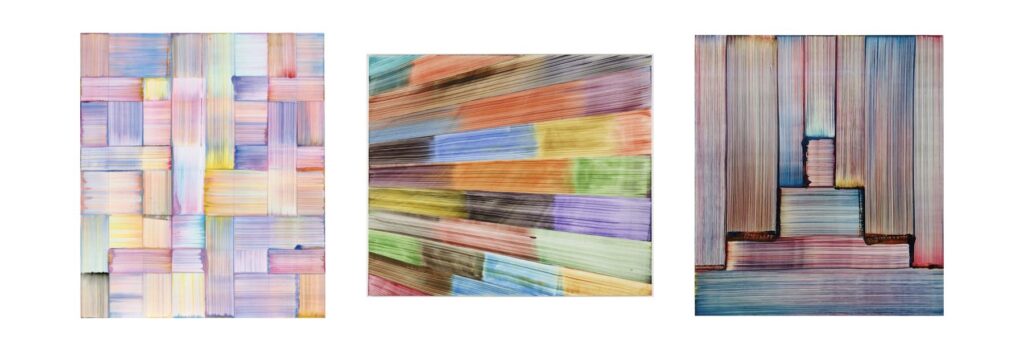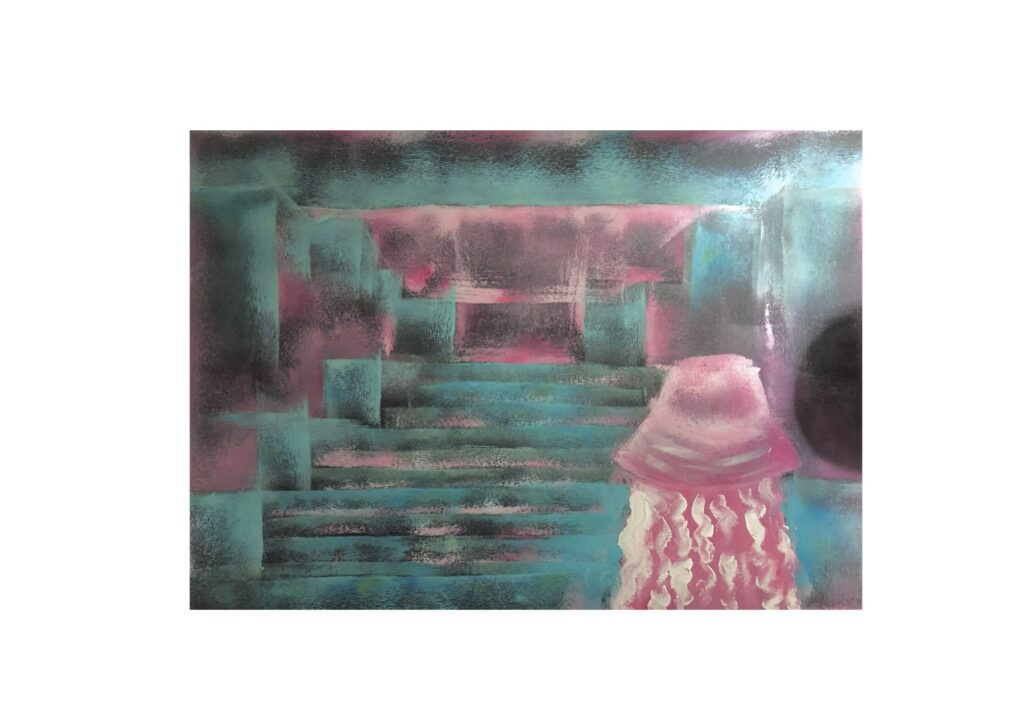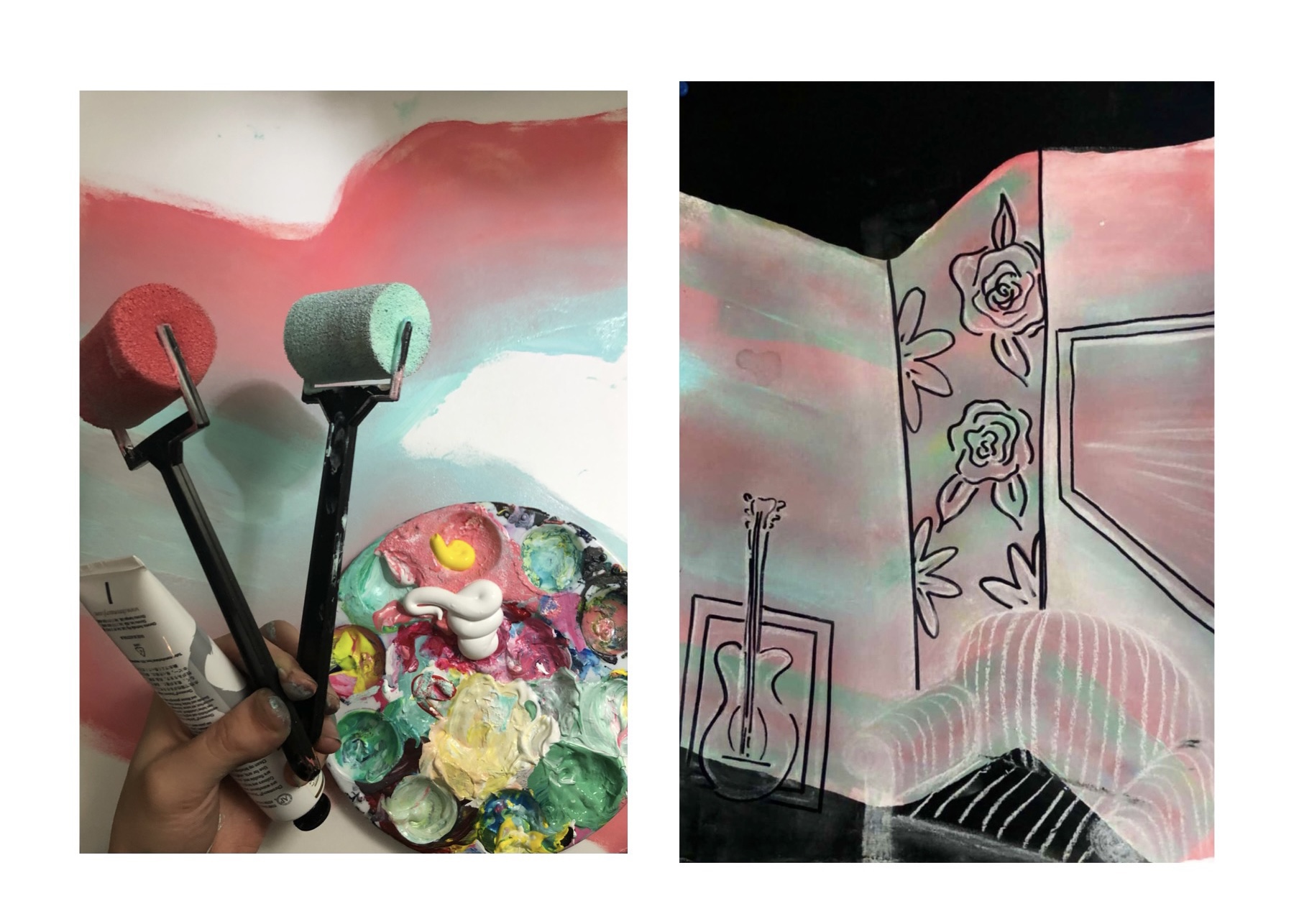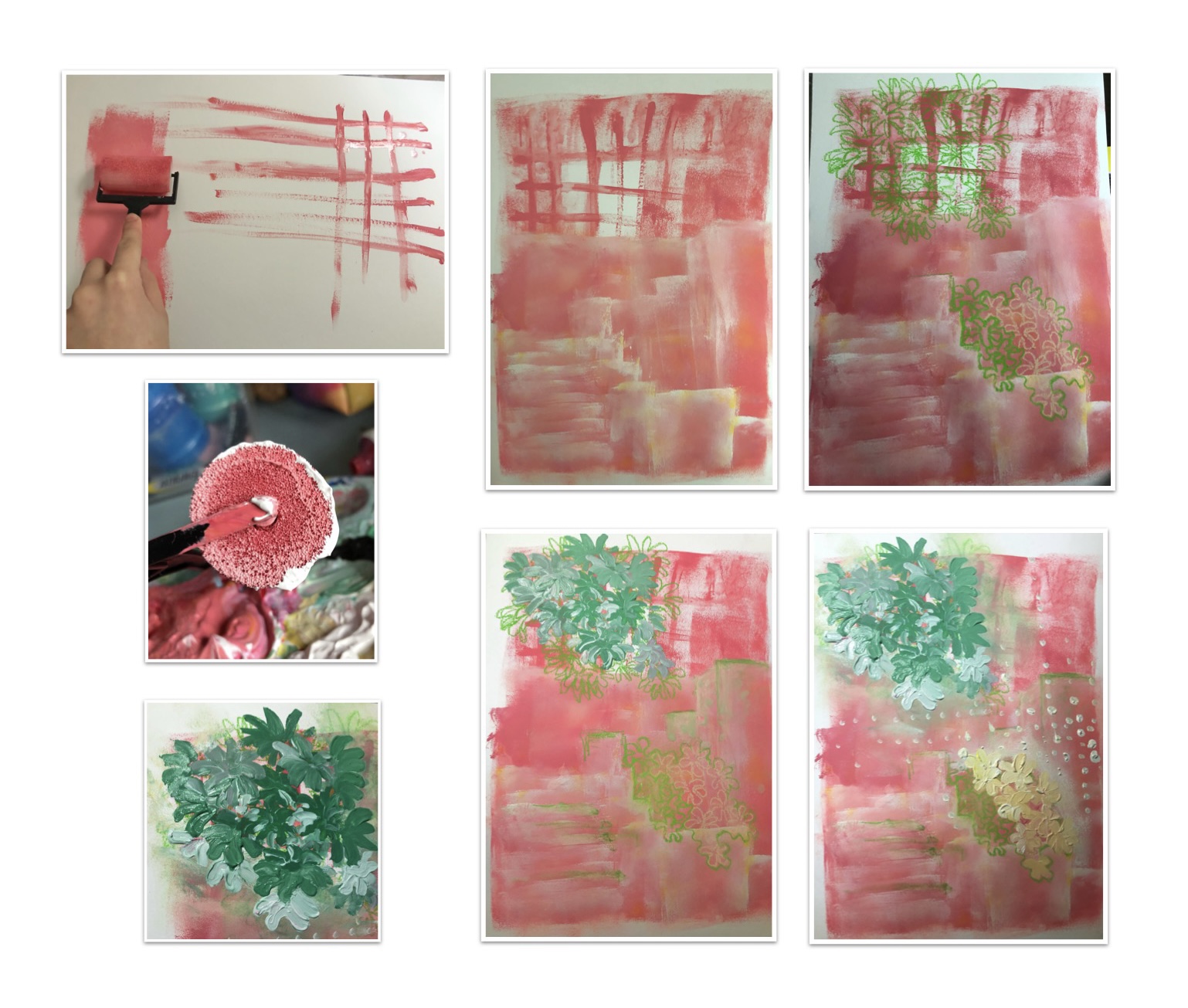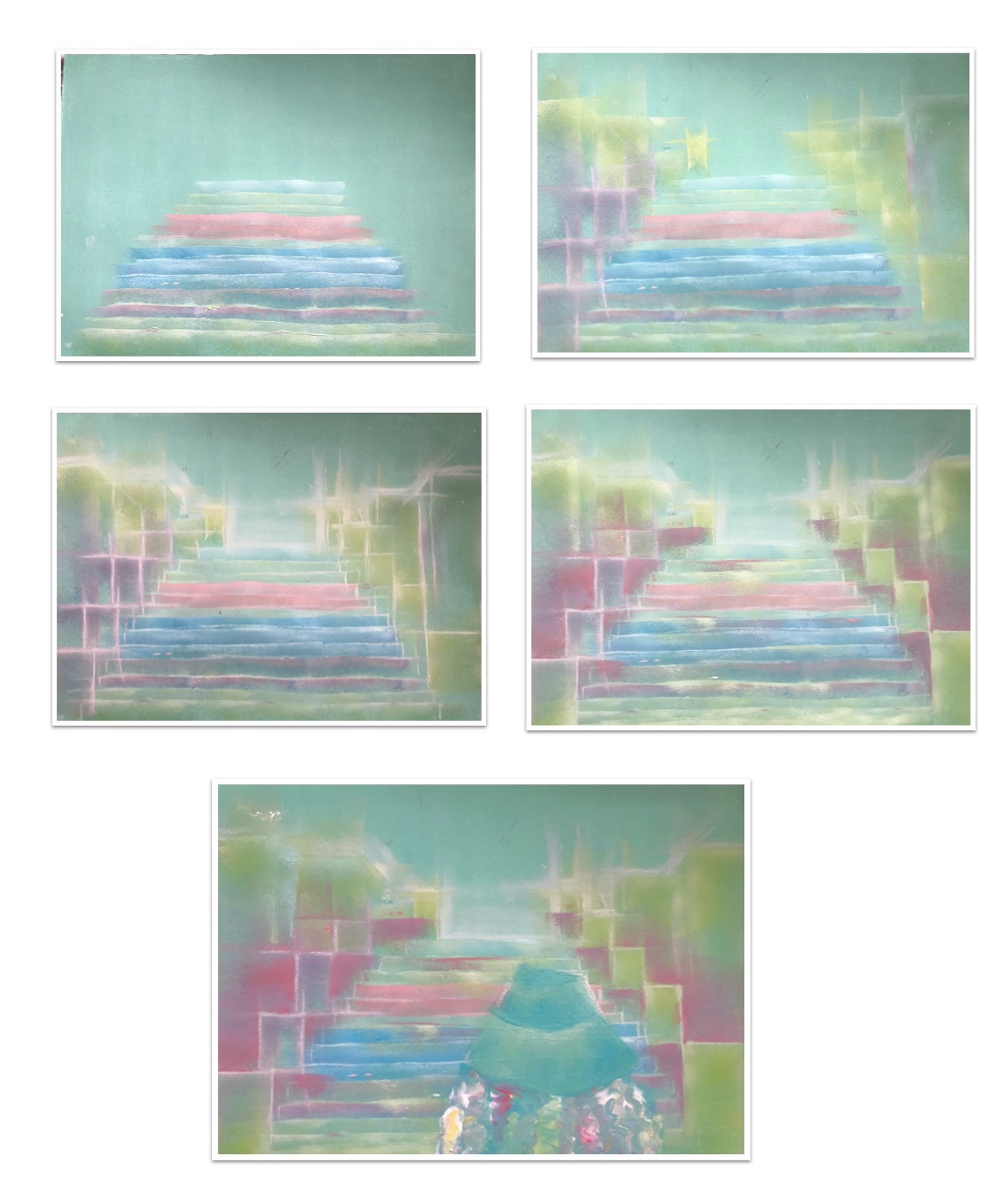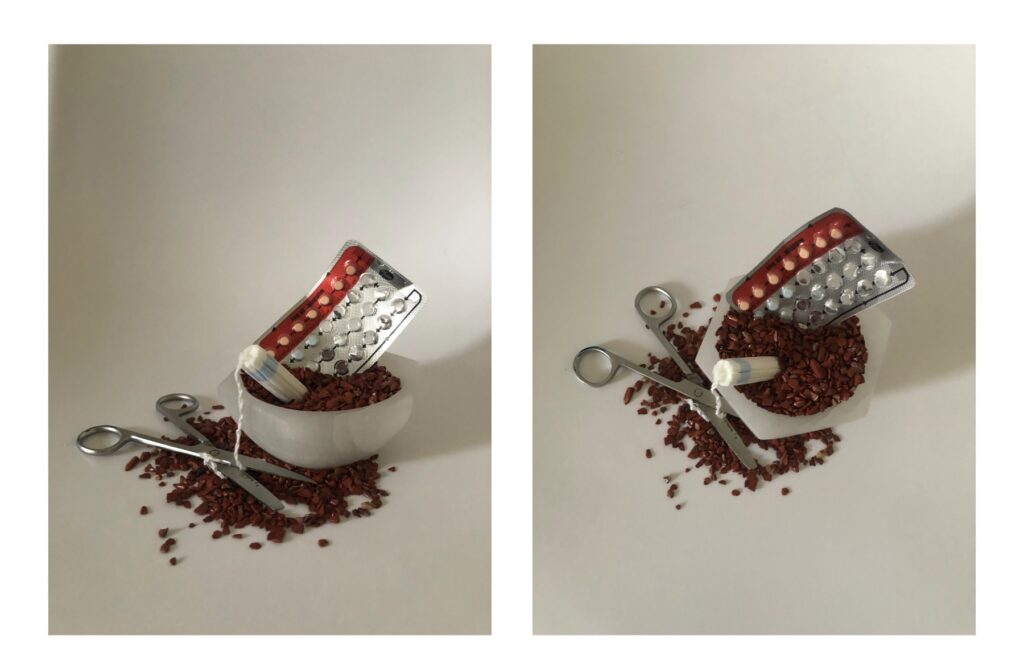
My first development draws and furthers ideas that i’ve identified upon reflection of my 3rd initial assemblage. Ideas identified in the 3rd initial assemblage I wanted to develop further, illustrating a more strong concise narrative of Feminism specifically deriving the idea linked from symbolisation of women and periods, as opposed to mental health (A concept that was more present in the 3rd initial assemblage). By selectively utilising a smaller variety of materials I have been able to execute an assemblage that presents the viewer a more concise, stronger narrative of feminism through the assemblage. I have chosen scissors, a singular tampon, almost empty birth control tray, red jasper crystals and a selenite crystal bowl. All these materials channel representation of strong empowering values and issues concerned around feminism in todays society.
When reflecting on materials this assemblage they collectively raise awareness of Feminism as the birth control and red jasper crystals when mindfully considered together in the assemblage arises initial thoughts of periods, fertility in women and concerns of unjust sexual activity expectations between women and men in current times. Red jasper crystals from a spiritual perspective serve with assistance in grounding the individual and is aligned with the root chakra. It is important we embrace the theme of the Divine Feminine, especially during todays time where as a collective society that is becoming more open minded and accepting to people of all diverse backgrounds and cultures. By using red jasper crystals this signifies a sense of grounding and alignment that everyone should channel into when connecting with their Divine Feminine. I don’t connect the word feminine to be related immediately to ‘women’, as femininity is a characteristic every human carries, though how much they resonate and connect with that side is dependent on the individual.
I have included scissors in this development, as they generate a loud statement upon initial observation of assemblage. The way in which I have chosen to assemble the materials depicts a strong narrative of feminism, as the scissors are positioned in a way which is about to cut the tampon string; this depiction I feel can be described as loud and/or with power, as the assemblage is a still piece, yet providing a sense of being on edge, or drastic. This drastic sense the assemblage presents us immediately draws in the observers attention, leaving viewers pondering curiously about the why? Why are the scissors depicted in mid action use?
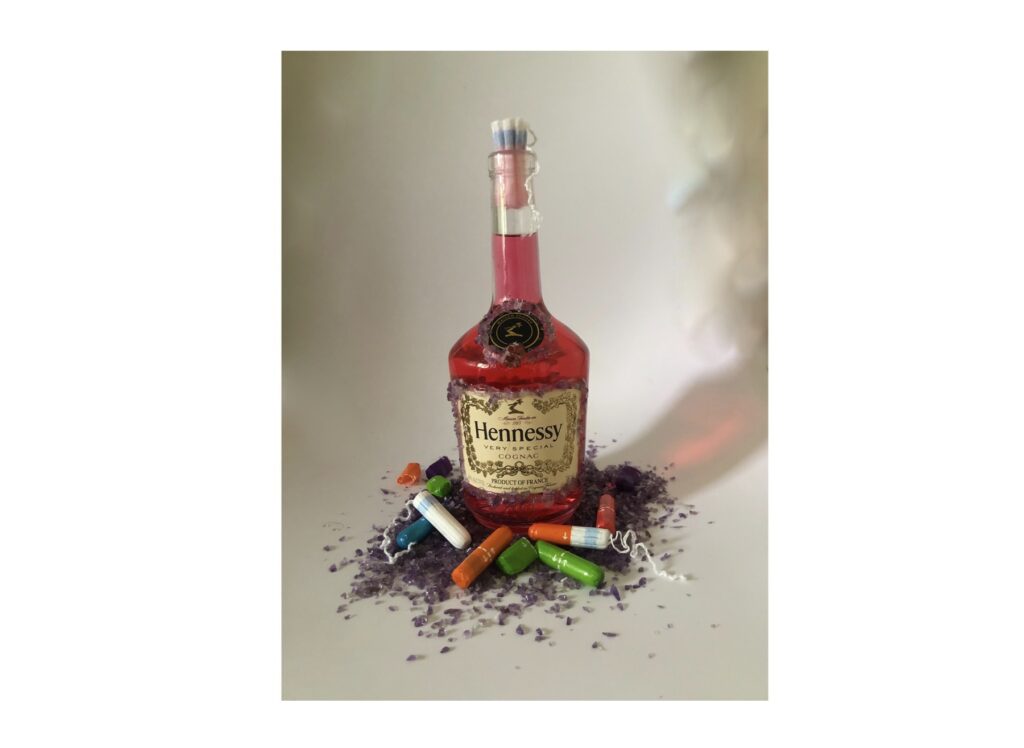
In this development I have furthered ideas from my initial assemblages by identifying different aspects and combining those in this development. Upon reflecting on my 3rd initial assemblage I observed different ideas correlating with the materials used while also identifying concepts I could further in my developments. These being the birth control and the red crystals, correlated with embracing themes Feminism amongst the assemblage
In my 2nd initial assemblage I utilised paint in a non-traditional way, this was by creating a pink/red liquid formed by mixing paint with water. I transferred this idea to this development in assistance to communicate with clarity a narrative of feminism. Upon observing the assemblage, a tampon has been used in place of the lid, using the paint water to expand the tampon, I could fully seal the opening. With a few tampons slightly open laying around that wouldn’t be utilised for their initial purpose, I repurposed these tampons, furthering links to narratives of feminism throughout all materials in this assemblage.
Placing the amethyst crystals as a base for the assemblage, a base for the centrepiece this directly reflects narratives of feminism through a assemblage of personal founded materials. Amethyst crystals from a spiritual perspective are natural calmer, providing clarity for the mindset, relieving stress, strain and anxiety, alongside providing assistance in spiritual awareness while opening and enhancing your intuition. Utilising this as the base of the assemblage brings forth a calmer presence in the assemblage. Feminine traits are commonly linked to motherhood from a traditional perspective, the tampons reflect a link to periods, thus embracing ideas of the Divine Feminine that mothers carry.
A personal connection between me and this assemblage is formed as I carry strong opinions and views around feminism. Through linking ideas of the Divine Feminine through the visual language in the assemblage this identified the Divine Feminine in mothers, as a daughter of a single mother who has three daughters, I resonate strongly with this idea founded in this assemblage. This development was created with a vision to further communicate concepts of the Divine Feminine through personal founded materials. I have executed an assemblage that when reflected on, arises and identifies idea of feminism and/ or the Divine Feminine, specifically around mothers, conveying appreciation and acknowledgement that being a mother is difficult and is a matter of trust the process and your intuition.
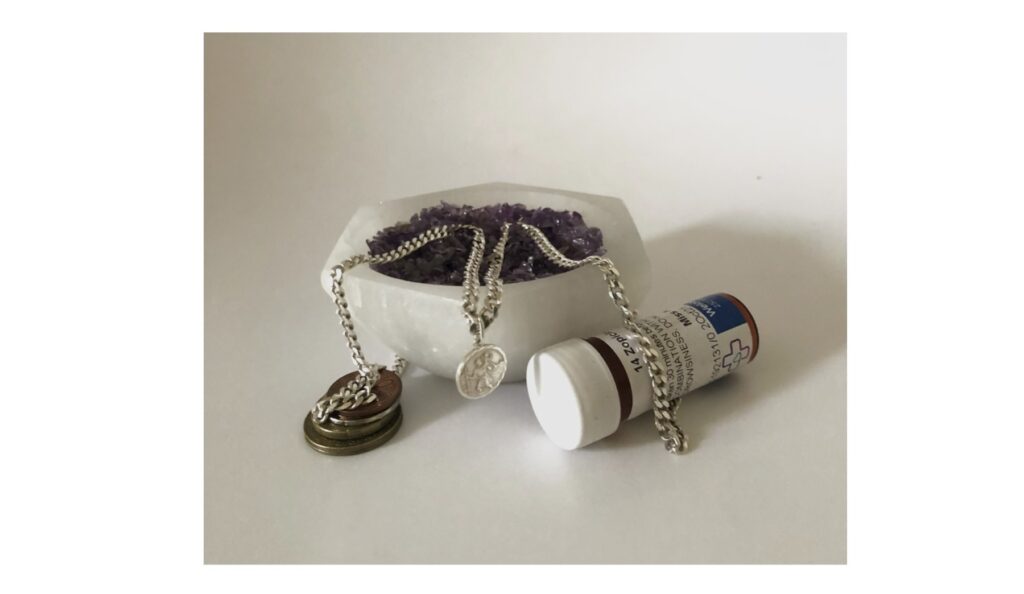
Materials chosen to for this development are from materials utilised in my initial assemblages. By restricting material options, this boosted my creative thinking for this brief, allowing me to channel majority of my energy and creative thinking towards the process of forming developmental assemblages, doing so mindfully resulted in deeper conceptual ideas, many of these can be correlated to ideas discussed in my theory lectures.
This development I wanted to approach the assemblage process in a way that goes against how selected materials would traditionally be placed together. This depicts a subtle change of traditional use, arising curiosity in the viewer as to why each item has been carefully placed as it as opposed to placing the items in the bowl and loose crystals underneath the bowl. This assemblage differs from other assemblages, containing the loose crystals only to inside the selenite bowl while the coins and medicine bottle reside outside of the bowl. Upon observing this assemblage deeper we can identify the necklace to be the centrepiece, and the link between the coins, crystals and medicine bottle.
Utilising the medicine bottle came from my natural reaction to ‘repurpose’, the first development assemblage derived from my 3rd initial assemblage, utilising only the birth control tray from the medication in the 3rd initial assemblage . I happened to have the coins in eyesight, with intention to play with energy and attributes the coins may add. Upon addition of coins I immediately was presented with reflection to balance scales, depicted with very loose conceptual visual language. I observed the assemblage and kept in mind the materials and ideas they brought forth, the materials mindfully depict a simple summary of ideas that the artist is balancing on the scale, capitalist expectations concerning money and their (mine, Kayla) own medical issues, while using spirituality (represented by crystals) to support the individual alongside counteracting energy draining aspects of day-to-day life.
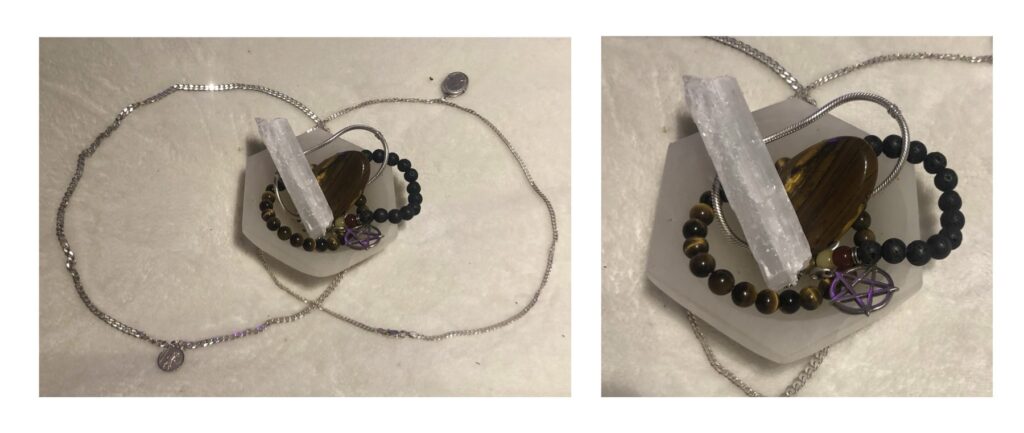
From my initial assemblages I wanted to develop the more simple ideas and concepts I drew from the assemblages. I have furthered an idea drawn from my last initial assemblage which concerns itself with geometric shapes observed in random material. By interlocking two necklaces of similar character (both being of sentimental value) we can notice the three shapes the necklaces create. My thought process correlated the interlocking circles to a ‘Venn diagram’. A Venn diagram aids in illustrating various ideas in a logical, thought out process, personally my idea of a Venn diagram assists in identifying common denominators between different ideas, concepts, people, things and more, resulting with a logical way to mindfully sought out what these common denominators are, encouraging a non-biased mindset on the individual.
For this development assemblage I limited my material selection further from my room to then solely immediate items near me at that current time. Materials chosen are my partner and I’s jewellery that resides right next to the bed, or is being worn on us, as well as two crystals that I keep on me everyday, a selenite crystal and a tigers eye. The selenite crystal bowl continues a sense of fluidity in my assemblages and developments alongside providing a distinct centrepiece in the sculpture, immediately drawing your gaze to the bowl. Continuing to observe this assemblage the selenite bowl resides on top of the two interlocking necklaces, in the section I identify as for ‘common denominators’.
Moving away from a literal sense, if we observe the necklaces while mindfully thinking of traditional art, we can relate this in our mind to colour theory. Colour theory is a key factor considered when creating traditional artworks. Once again, this idea can be correlated to my idea of a Venn diagram, identifying the common denominator (example: common denominator of blue and yellow is green)
Throughout this brief I have furthered a personal connection with my creative works in all areas. By carefully considering the materials, process and criteria I can provide myself, as opposed to cutting corners, I have founded a new appreciation all creative works. From this brief (and all other briefs this year) I have succeeded in finding 100% satisfaction with every creative work I produce, as if it isn’t the final product then its a learning curve, something to develop on. By seeing, identifying and breaking down the positive changes of my new approach to creative processes, Ive learnt, benefited and continue to use my skills learnt that great fully assist in communicating ideas and concepts through visual language.

